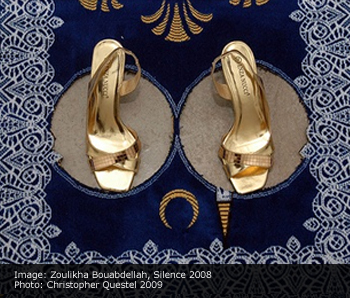Women, Art and Islam
By Mohamed Keita
Perspectives: Women, Art and Islam at the Museum of Contemporary African Diasporan Arts (MoCADA) lives up to its title, aptly providing deep insight into five disparate lives shaped by Islam, the West, and everything in between. With roots in Bangladesh, Algeria, Pakistan, Morocco, and New York City, the artists utilize family photographs, spiritual poetry, Quranic verses, and personal accessories to shed insight into the personal conflicts of Muslim women who face religious pressures to fulfill social expectations at the expense of personal aspirations.
Terrorism and the treatment of women have largely defined Islam in public discourse in recent years. In response, Perspectives challenges the notion of Islam as a monolithic, misogynist, unimaginative and atavist faith. This is no small task, yet it is achieved with a remarkable fusion—from modern photography, painting, installation and video to traditional Islamic crafts like tilework, ceramics and calligraphy.
The exhibition space itself, a series of large rooms and intimate corners, provides disparate experiences. The artwork’s power may well be what it does not openly express, but perhaps, quietly hints.
Pakistani-American artist Mahwah Chisty dims the lighting of her wire-suspended installations and projects Kufi script through a pool of water. More subtle is Safaa Erruas’s (Morocco) spine-like wall installation of cotton and a thousand needles, “Moon Inside Me,” which bathes in whiteness and light. Next door, Brooklyn-born Nsenga Knight fills a corner with sounds of her video interviews of African-American Muslim women converts; the sounds and images bounce off a wall piece with silk-screened words from the writings of Ibrahim Abd ar-Rahman, a West African prince abducted into slavery.
Algerian Zoulokha Bouabdellah appears in a sequence of self-portrait photographs with couscous pots covering in turn her eyes, ears and mouth as if to say see no evil, hear no evil, speak no evil. Finally, Chisty completes the full circle with a wall of colorful paintings displaying Islamic words and epigrams in interlaced calligraphic designs of the Kufi style. It is Chisty’s inclusion of materials, such as coral grains and glass, that push this traditional art into the present.

